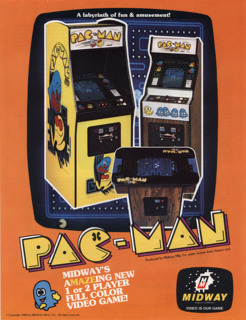Pac-Man Fiasco!
At Christmas Eve, the traditional time in which my family opened presents, I barely had enough time to say thank you after I opened it up before my nervous excitement literally pushed my legs up, pushed me into the play room, and pushed that cartridge into the Atari. I turned the machine on, braced myself, and watched in a stupor!
The game began with a siren call that sounded like an asthmatic trying to breathe through a whistle. Pac-Man himself was nothing more than a curly inchworm trying his best to spell the letter "C." As he moved around the maze, he only ever switched his game from left to right, NEVER up or down. Instead of pellets, he swallowed tablets (and super blocks). Instead of bonus "fruit", he took an antacid. Every bite he took sounded like a guitar string stretched to its limit and plucked with a fishing hook. The maze would have been alright, were it not for the odd decision to put the escape tunnel at the top and bottom instead of right and left. The monsters, on the other hand, were indistinguishable from each other, with eyes that twirled around constantly like a kid who has been spun around one too many times. The frame rate for the monsters was horrid. Each of the monsters flickered so badly that they seemed to be transparent one moment and invisible the next. The manual itself tried to explain these flickering monsters away by calling them "ghosts" instead. Oddly, that didn't seem any more dishonest than Atari's insistence on calling this monstrosity "Pac-Man". I tried my best to hide my disappointment and stay interested, but I had had enough in less than five minutes. Having to walk ten miles to the nearest arcade and wait in line for two hours for the real thing was better than this.
That Christmas wasn't a total loss. I learned the very important life-lesson that sometimes grown-ups lie. In this case, the grown-ups that lied were anyone at Atari who had marketed this game as a "faithful port", as "fun and exiting", as "providing hours of gameplay", or worse yet, as "Pac-Man". Now some might say, "Well, it was the Atari 2600, what did you expect from a system with those types of limitations?" Anyone who takes a look at the much more acceptable port of "Ms. Pac-Man", or the superior port of "Jr. Pac-Man", knows that the issue here isn't that the hardware wasn't capable of a reasonably good port. The issue was deficiencies in development, marketing, and overall management. Everyone had a hand in this terrible incident, even those of us who, without thinking, trusted Warner Communications and Atari to keep their word without any kind of proof that they had quality and customer satisfaction in mind.
The gaming industry has learned some lessons as a whole from this experience as well, and subsequently changed for the better. After the recession the video game industry went through beginning in 1983, Nintendo and Sega both entered the field with new consoles, new ideas, and above all, a new strong customer-satisfaction ethic. They started a trend of giving previews, showing screen-shots, and describing gameplay for games that were in development as they progressed. It's a trend that has helped gamers like me to avoid being a victim again. At least something came out of this terrible experience.

